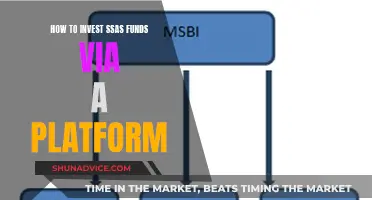
Mutual funds are a great way to build wealth and retire with a substantial sum of money. However, with thousands of mutual funds available, choosing the right one can be challenging. Here are some essential factors to consider when selecting the best mutual fund for your investment goals:
- Investment goals and risk tolerance: Define your investment objectives and risk tolerance level. Are you investing for long-term capital gains or current income? Do you want steady growth with low risk, or are you comfortable with higher-risk investments for potentially greater returns?
- Management style: Decide between actively managed funds, where professionals actively buy and sell investments, and passively managed funds (index funds) that aim to replicate the performance of a benchmark index. Actively managed funds often have higher fees.
- Fund types: Understand the different types of mutual funds, such as large-cap, small-cap, value, growth, income, and balanced funds. Each type has a different investment strategy, risk profile, and potential return.
- Fees and expenses: Mutual funds charge various fees, including sales loads, expense ratios, and transaction fees. Pay close attention to these fees as they can significantly impact your investment returns.
- Performance and track record: Evaluate the fund's past performance and the fund manager's track record. While past performance doesn't guarantee future results, it can provide insights into the fund's historical trend and volatility.
- Diversification: Diversifying your portfolio across different types of funds, sectors, and asset classes can help mitigate risk. Consider investing in a mix of equity funds, bond funds, and international funds to spread your risk.
- Time horizon: Consider your investment time horizon. If you need access to your money in the short term, aggressive growth funds may not be suitable. Target-date funds are a good option if you want the fund to automatically adjust its risk level based on your retirement timeline.
- Fund size and turnover: Larger funds may have more assets under management, indicating greater investor trust. Also, consider the fund's turnover ratio, which indicates how often the fund buys and sells investments. High turnover can lead to higher transaction fees and tax liabilities.
- Fund manager experience: Look for experienced fund managers with a successful track record. A good fund manager should have a deep understanding of the market and the ability to make strategic investment decisions.
| Characteristics | Values |
|---|---|
| Investment goals | Long-term capital gains, current income, college expenses, retirement |
| Risk tolerance | Dramatic swings in portfolio value, conservative investment |
| Time horizon | More than 5 years |
| Management style | Actively or passively managed |
| Fund type | Large-cap funds, small-cap funds, value funds, growth funds, income funds, bond funds, balanced funds |
| Fees | Sales fee/load, expense ratio, 12b-1 fees, transaction fees, management fee, 12b-1 distribution fee, other expenses |
| Past performance | Consistent with general market returns, volatility, turnover |
| Assets under management | $100 billion |
What You'll Learn

Consider your investment goals and risk tolerance
When selecting a mutual fund, it's important to consider your investment goals and risk tolerance. This will help you determine the types of funds that align with your financial objectives and comfort level with potential losses. Here are some key points to keep in mind:
Investment Goals
Firstly, define your investment goals. Are you investing for the long term, such as retirement, or do you have shorter-term financial goals? Do you prioritise capital appreciation, steady income, or a balance of both? Knowing your investment goals will help you choose between different types of mutual funds. For example, if you're investing for retirement and can tolerate a higher level of risk, you might opt for a long-term capital appreciation fund that focuses on common stocks. On the other hand, if you need current income, an income fund investing in bonds and debt instruments might be more suitable.
Risk Tolerance
Your risk tolerance refers to how comfortable you are with potential losses in your investment portfolio. It's important to assess your willingness and ability to tolerate large swings in the value of your investments. If you have a low-risk tolerance, you may prefer more conservative investments, even if they offer lower potential returns. Conversely, if you have a higher-risk tolerance, you might be willing to take on more volatile investments with the potential for greater long-term gains.
Time Horizon
Consider your investment time horizon, which is the length of time you plan to hold your investments. If you need access to your money within a few years, aggressive growth funds might not be suitable. Target-date funds are a good option if you want a fund that automatically adjusts its risk level based on your target retirement age.
Diversification
Diversifying your portfolio across different types of funds and asset classes can help manage risk. While equity funds are popular for their potential for long-term growth, bond funds can provide a steadier income stream and balance out the risk in your portfolio. International funds can also add diversification by spreading your investments beyond your home country.
Fund Performance and Fees
While past performance doesn't guarantee future results, it's worth considering a fund's historical returns and how they compare to relevant benchmarks. Additionally, pay attention to the fees associated with the fund, such as expense ratios and load fees, as these can impact your overall returns.
By carefully considering your investment goals and risk tolerance, you can make more informed decisions about which mutual funds align with your financial objectives and comfort level with potential risks and returns.
Property Funds: A Smart Investment Strategy for Diversification
You may want to see also

Understand the fund's management style
Understanding the fund's management style is a crucial step in choosing the best mutual fund for your investment. Mutual funds can be actively or passively managed, and each style has its own advantages and disadvantages.
Actively managed funds have portfolio managers who make decisions about which securities and assets to include in the fund. They conduct extensive research on assets, considering sectors, company fundamentals, economic trends, and macroeconomic factors. Active funds aim to outperform a benchmark index, and their fees are typically higher. The trade-off is that these funds can have high fees to compensate fund managers for their time and efforts. Therefore, it is essential to evaluate whether the fund's performance justifies the fees charged.
On the other hand, passively managed funds, often called index funds, aim to replicate the performance of a benchmark index. They have lower fees compared to actively managed funds and don't trade their assets very often. This low turnover results in reduced costs for the fund. Additionally, passively managed funds may hold thousands of assets, leading to a well-diversified fund.
When deciding between active and passive management, it is important to consider your investment goals, risk tolerance, and the level of involvement you want to have in managing your investments. Active management may be suitable for those seeking to outperform the market and are willing to pay higher fees. In contrast, passive management could be preferred by those seeking a more hands-off approach and lower fees.
It is also worth noting that the performance of actively managed funds and passively managed funds should be evaluated over the long term, as short-term results may not accurately reflect their potential.
Invest Smartly: Direct Mutual Funds Guide
You may want to see also

Know the differences between fund types
There are several types of mutual funds, each with its own investment focus and strategy. Here are some of the most common types:
- Stock Funds: These invest in the stock market, often focusing on a specific sector or type of stock. For example, a fund might focus on technology or healthcare stocks, or on growth or value stocks.
- Bond Funds: Bond funds invest in bonds and other debt instruments issued by corporations and governments. They aim to provide regular income through interest payments.
- Money Market Funds: These funds invest in high-quality, short-term securities issued by corporations and governments. They are relatively low-risk but tend to provide lower returns.
- Target-Date Funds: These funds adjust their portfolio mix over time based on a target date, such as a retirement date. They typically become more conservative as they approach the target date.
- Index Funds: These funds aim to replicate the performance of a specific index, such as the S&P 500 or the Dow Jones Industrial Average (DJIA). They tend to have lower fees and are passively managed.
- Actively Managed Funds: Actively managed funds aim to outperform the market by having fund managers hand-pick stocks, bonds, or other securities. They tend to have higher fees due to the active management and more frequent trading.
- Growth Funds: These funds focus on capital appreciation and typically invest in stocks with high growth potential. They are usually riskier and more volatile than other types of funds.
- Income Funds: Income funds aim to provide regular income, often in the form of dividends or interest. They may invest in dividend-paying stocks, bonds, or a combination of both.
- Capital-Preservation Funds: These funds invest in short-term, low-risk securities such as US Treasury bills and CDs. They aim to preserve the initial investment while providing some returns.
- Asset Allocation Funds: These funds automatically adjust their holdings over time to balance growth and stability, making them suitable for investors nearing retirement.
When choosing between different types of mutual funds, it's important to consider your investment goals, risk tolerance, time horizon, and management style preference. Each type of fund has its own advantages and disadvantages, and the right choice will depend on your individual circumstances and preferences.
Oil Fund Investment: A Guide to Getting Started
You may want to see also

Evaluate fees
Fees are an important consideration when selecting a mutual fund. The fees may vary depending on whether you choose a passive or actively managed fund. Passive funds tend to have lower fees than active funds. Passive funds, also called index funds, aim to track and duplicate the performance of a benchmark index. They are often considered to be less risky than active funds. Active funds, on the other hand, have portfolio managers who actively make investment decisions and try to outperform the market. The fees for active funds are meant to compensate fund managers for their time and expertise.
When evaluating fees, look at the expense ratio, which is the percentage of assets paid to run the fund. The expense ratio covers various costs, including the management fee, the 12b-1 distribution fee, and other expenses. According to Fidelity, the average expense ratio for actively managed equity funds was 0.65% in 2023, while index funds had an average expense ratio of 0.05%. Actively managed funds may also charge load fees, which are sales commissions paid when buying or redeeming shares. These fees typically range from 1% to 2% but can go as high as 8.5%. Load fees can be front-end, paid when buying shares, or back-end, charged when selling shares. No-load funds, on the other hand, do not charge load fees, but they may have higher management expense ratios or other fees.
It is important to carefully consider the fees associated with a mutual fund as they can significantly impact your investment returns. Even small percentage differences in fees can add up to tens of thousands of dollars over time. Therefore, it is crucial to weigh the potential benefits of active management against the higher fees charged by active funds.
In addition to the expense ratio and load fees, consider the fund's turnover ratio, which indicates how often the fund's management team buys and sells investments. A high turnover ratio may result in higher transaction fees and create more short-term capital gains, which are taxed at a higher rate. This is especially important for taxable accounts, as it can impact your overall returns.
Key Factors for Choosing the Right Mutual Fund Investments
You may want to see also

Research and evaluate past performance
Researching and evaluating the past performance of a mutual fund is a crucial step in the investment process. Here are some detailed instructions on how to approach this:
Compare with Peer Funds
It is advisable to compare the mutual fund's performance with similar funds in the same category. This allows you to assess its relative performance and identify any consistent outperformance or underperformance. Compare the returns and risks associated with these funds over different periods, such as one year, three years, or five years. This will provide insight into how the fund has navigated various market conditions.
Study the Fund's History
Examining the historical performance of a mutual fund gives valuable insights into its consistency and ability to generate returns over different market cycles. Assess how the fund has performed during bull and bear markets. A desirable fund would demonstrate resilience during downturns and capture a significant portion of market upswings. Additionally, evaluate any managerial changes and their impact on the fund's performance. A stable and experienced management team is generally preferable.
Evaluate Risk-Adjusted Returns
When evaluating a mutual fund's performance, it is essential to consider risk-adjusted returns. This means assessing the returns generated relative to the level of risk undertaken. Financial metrics like the Treynor ratio and the Sharpe ratio can aid in this evaluation. The Treynor ratio focuses on systematic risk, using beta as the measure, while the Sharpe ratio considers total risk, utilising standard deviation. These ratios help identify funds that generate higher returns for the market risk they take.
Analyse Rolling Returns
To gain a comprehensive understanding of the mutual fund's performance, it is advisable to analyse rolling returns. This involves breaking down the returns into smaller increments, such as monthly, quarterly, or yearly returns, rather than focusing solely on the overall returns since the fund's inception. This approach helps evaluate the fund's performance during different market conditions and over various timeframes, providing a more nuanced perspective.
Compare Performance Against a Benchmark
Every mutual fund has benchmark indexes, such as the Nifty, BSE Sensex, or BSE 200, against which its performance is evaluated. Compare the fund's total returns over different periods with the returns of the benchmark. This will help determine if the fund has consistently outperformed or underperformed the market. Additionally, consider the fund's alpha and beta. The alpha indicates the excess returns generated relative to the benchmark, while the beta quantifies the fund's volatility relative to the benchmark.
M1 Finance: Invest in One Fund for Easy Diversification
You may want to see also
Frequently asked questions
Actively managed funds are run by professionals who buy and sell investments for the fund. They aim to beat the market but rarely do so. Passive funds, on the other hand, track an existing market index and tend to be cheaper and perform better.
First, check the minimum investment amount for the mutual fund. Many mutual fund minimums range from $500 to $3,000, though some are in the $100 range or even $0. Then, decide how much money you have to invest comfortably.
Generally, the closer you are to retirement age, the more holdings in conservative investments you may want to have. Younger investors typically have more time to weather the highs and lows of the stock market.
If you're just starting out, consider broad mutual funds that invest in different areas of the stock market. You can look at a market index like the S&P 500, which covers around 500 of the largest US companies.







